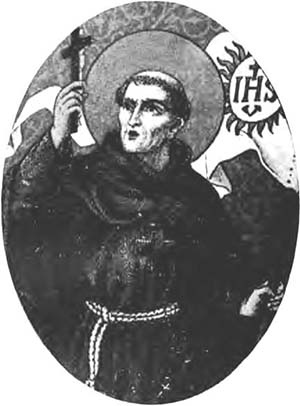Saint John of Capistrano
Feast Day October 23

Imagine living in a country where deadly plague and civil wars have decimated the population and continued for years to threaten the living. Envision, too, suffering the confusion of a church in which two and sometimes three men claimed to be pope. Finally, pretend having responsibility for a religious order bitterly divided into opposing camps. These troubled circumstances provide a backdrop for the life of St. John of Capistrano and give us some perspective on his actions. John studied law at Perugia, Italy, where he married the daughter of a leading citizen and, in 1412, became the governor.

In 1416, while in jail as a political prisoner, he experienced a conversion and decided to become a religious. Somehow he got his wife to release him. He paraded through Perugia seated backward on a donkey and wearing a paper hat that listed all his sins. Having humiliated himself in this bizarre repentance, he applied to the Franciscans of the Strict Observance and they accepted him.
Immediately, the order put John on the fast track. Ordained in 1420, the Observants commissioned him to preach all over the Italian boot. With his remarkable gift for speaking, he revived the hope of thousands whose faith had eroded in the chaotic fourteenth century. He preached repentance to laity and clergy alike, as the following exhortation to priests shows:
Those who are called to the table of the Lord must glow with the brightness that comes from the good example of a praiseworthy and blameless life. They must learn from the eminent teacher, Jesus Christ. . .“You are the light of the world” (see Matthew 5:14). Now a light does not illumine itself, but instead it diffuses its rays and shines all around upon everything that comes into its view. So it must be with the glowing lives of upright and holy clerics. By the brightness of their holiness they must bring light and serenity to all who gaze upon them. They have been placed here to care for others. Their own lives should be an example to others, showing how they must live in the house of the Lord.
John of Capistrano collaborated with his mentor, St. Bernardino of Siena and with St. Colette in reforming the Franciscans. He helped them navigate a balanced course between two extremes, disciplining both the overly lax and the overly austere.
Many find two of John’s later activities disturbing. The pope sent him as inquisitor to Austria in 1451. Some roundly criticize him for his severity in dealing with recalcitrant Hussites. And in 1456, it fell to John to raise an army and help turn back the Turks from Belgrade. His campaign succeeded, but many believe his involvement in a military action was inappropriate for a cleric. After the battle at Belgrade so many bodies lay unburied that pestilence spread, and John succumbed to disease on October 23, 1456.
Image credit: San Juan Capistrano by unknown artist, unknown date. Public Domain via Wikimedia.

